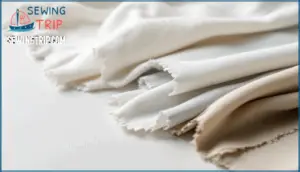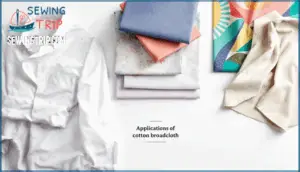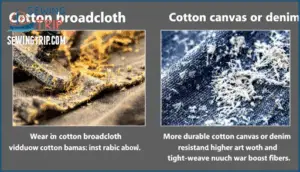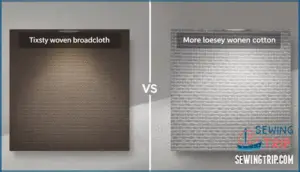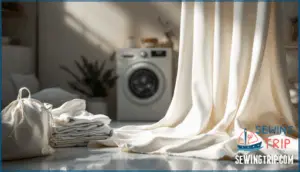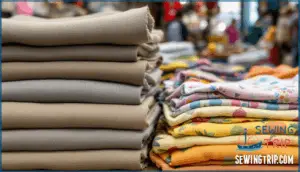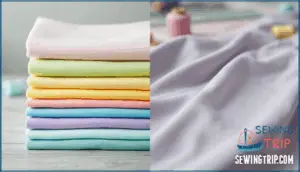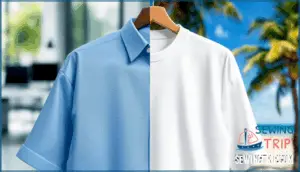This site is supported by our readers. We may earn a commission, at no cost to you, if you purchase through links.
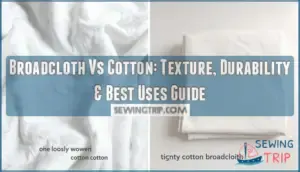
Understanding this distinction affects everything from how your dress shirt holds its shape to whether your quilt will stand up to repeated washing. The texture, durability, and care requirements shift dramatically depending on whether you’re working with loosely woven cotton or the dense structure of true broadcloth.
Table Of Contents
- Key Takeaways
- Broadcloth Vs Cotton: an Overview
- What is Broadcloth Made Of?
- What is Cotton Broadcloth Used For?
- Broadcloth Vs Cotton: Differences in Texture and Feel
- Broadcloth Vs Cotton: Differences in Durability and Strength
- Broadcloth Vs Cotton: Differences in Breathability and Comfort
- Broadcloth Vs Cotton: Differences in Wrinkling and Care
- Broadcloth Vs Cotton: Differences in Price and Availability
- Broadcloth Vs Cotton: Which is Better for Quilting?
- Broadcloth Vs Cotton: Which is Better for Clothing?
- Frequently Asked Questions (FAQs)
- Conclusion
Key Takeaways
- Broadcloth refers to a tight plain-weave structure (not a fiber type), meaning you can find cotton broadcloth, polyester broadcloth, or silk broadcloth—each with different properties based on the fiber used.
- Cotton broadcloth’s dense weave (120–200 threads per square inch) creates a smoother, more wrinkle-resistant fabric than standard cotton, but it sacrifices breathability and traps moisture against your skin in warm weather.
- For quilting projects, standard cotton outperforms broadcloth because its lighter weight (4–5 oz per square yard) and flexible structure make piecing and layering easier without fighting stiff fabric.
- When choosing between the two, match broadcloth’s structure and shape retention to fitted garments or formal wear, and reserve standard cotton for breathable everyday clothing or craft projects where comfort trumps polish.
Broadcloth Vs Cotton: an Overview
If you’ve ever stood in a fabric store wondering whether broadcloth and cotton are the same thing, you’re not alone. The confusion makes sense because broadcloth can actually be made from cotton, but it can also come from wool, silk, polyester, or rayon. The key difference lies in the weave structure, not just the fiber content.
Broadcloth refers to a specific type of plain weave fabric with a tight construction that creates a smooth, lustrous finish. Cotton, on the other hand, describes the raw fiber itself. Historically, broadcloth was woven on wide looms—hence the name—and was prized for its dense, durable qualities.
Today, when you compare broadcloth vs. cotton in modern applications, you’re often looking at cotton broadcloth versus plain cotton fabric. Both work well for clothing and craft projects, but broadcloth’s tighter weave gives it a more opaque appearance and polished texture, while standard cotton fabric is typically lighter and more breathable.
What is Broadcloth Made Of?
Broadcloth traditionally started as a wool fabric, but today you’ll find it made primarily from cotton, with silk, polyester, and rayon versions also available depending on the application you need. The fiber content directly affects the fabric properties you’ll experience. Cotton broadcloth offers breathability and comfort, while wool broadcloth provides warmth and structure. Silk broadcloth brings a luxurious drape, and rayon broadcloth mimics silk at a lower cost.
The material composition impacts how you’ll care for and use the fabric:
- Weave density remains consistent across types, creating that signature smooth finish
- Cotton broadcloth is the most common for everyday garments and quilting projects
- Polyester blends add wrinkle resistance and durability to the base fiber content
What is Cotton Broadcloth Used For?
You’ll find cotton broadcloth in everything from crisp button-down shirts and breezy summer dresses to quilt backings and even lightweight curtains, thanks to its smooth finish and reliable grip on vibrant dyes. The fabric’s tight weave makes it reliable for sewing projects where you need clean edges and minimal fraying.
Garment applications dominate broadcloth for clothing, particularly in dress shirts, pajamas, and lightweight blouses where the smooth texture feels comfortable against your skin. Beyond garments, home decor benefits from broadcloth for curtains that block light effectively while maintaining shape. Craft projects often incorporate this material as broadcloth for lining in purses, tote bags, and quilted items.
| Application Category | Common Uses |
|---|---|
| Garment applications | Button-down shirts, dresses, pajamas, lingerie |
| Home decor | Lightweight curtains, decorative pillowcases |
| Craft projects | Quilt backings, bag linings, costume construction |
Medical textiles occasionally use cotton broadcloth for scrubs and patient gowns, while industrial uses include protective garment linings where breathability matters.
Broadcloth Vs Cotton: Differences in Texture and Feel
When you run your hand across broadcloth, you’ll notice its signature smoothness—that crisp, almost polished surface comes from a tight plain weave with thread counts often exceeding 60×60 per inch. Broadcloth strikes a balance between cotton softness and fabric stiffness, giving you structure without feeling rough. The weave influence is clear: broadcloth’s dense construction creates a firmer hand feel with less give, while looser cotton weaves drape and flex more freely. You’ll find broadcloth holds its shape better for fitted pieces, though it won’t match the plush comfort of brushed cotton. Surface smoothness in broadcloth rates "neutral" to "soft" in textile studies, with that slight luster that makes dress shirts look polished. Broadcloth’s creation involves a complex manufacturing process to achieve its texture.
Regular cotton fabrics span a much wider range, from buttery jersey to rugged denim, depending on how they’re woven.
| Characteristic | Broadcloth | Regular Cotton |
|---|---|---|
| Surface texture | Smooth, slightly lustrous | Varies from soft to textured |
| Hand feel | Crisp, structured | Ranges from firm to flowing |
| Stiffness level | Medium body, holds shape | Lightweight to heavyweight |
| Weave type | Tight plain weave | Plain, twill, jersey, satin |
Broadcloth Vs Cotton: Differences in Durability and Strength
Strength and durability are key factors in determining whether a fabric can withstand everyday wear or will fray after a few washes. Cotton broadcloth typically endures around 2,500 Martindale cycles before showing yarn breaks, which is decent for moderate use but not exceptional. In contrast, heavier cotton variants like denim can survive over 8,000 cycles, while polyester broadcloth exceeds 3,500 cycles. Understanding how fabrics hold up to friction requires abrasion resistance testing.
Tensile strength in cotton fabrics ranges from 2,870 to 5,970 psi when dry, with broadcloth’s plain weave offering moderate resistance. Thread count plays a significant role: broadcloth typically has 120 to 200 threads per square inch, while higher-density cottons exceed 220 threads, providing better abrasion resistance. Blending polyester with cotton can enhance strength by 15–40%, significantly extending a garment’s lifespan.
| Durability Factor | Cotton Broadcloth | Other Cotton Fabrics |
|---|---|---|
| Abrasion resistance | ~2,500 Martindale cycles | 6,000+ (canvas, denim) |
| Thread count | 120–200 per sq. inch | 100–300+ per sq. inch |
| Fiber breakdown | 16% loss after 50 washes | Varies by weave density |
Broadcloth Vs Cotton: Differences in Breathability and Comfort
How do fabric structures impact air permeability and thermal regulation? Cotton broadcloth’s tight plain weave (120–200 threads per square inch) reduces air permeability to roughly 80–120 cubic feet per minute (CFM), while standard cotton fabrics with looser weaves achieve 150–200 CFM.
This density difference directly affects moisture-wicking capacity: broadcloth absorbs moisture but traps it against your skin, whereas looser cotton weaves allow 25–40% faster evaporation. The tighter construction in broadcloth can increase skin irritation for sensitive individuals due to reduced ventilation. When comfort perception matters most—especially in warm conditions—standard cotton’s better breathability wins.
Broadcloth’s tight weave traps moisture against your skin, while looser cotton fabrics allow 25–40% faster evaporation for better comfort in warm weather
| Breathability Factor | Cotton Broadcloth | Standard Cotton |
|---|---|---|
| Air permeability (CFM) | 80–120 | 150–200 |
| Moisture evaporation rate | Moderate (slower) | Fast (25–40% quicker) |
| Thermal regulation | Limited airflow | Enhanced ventilation |
| Skin irritation risk | Higher (tight weave) | Lower (better airflow) |
| Comfort in warm weather | Adequate | Better |
Broadcloth Vs Cotton: Differences in Wrinkling and Care
Why does your washing machine become your worst enemy with some fabrics but not others? Cotton broadcloth’s tight weave (120–200 threads per inch) resists wrinkling better than standard cotton, which creases easily due to looser fiber structures. You’ll find that broadcloth maintains its smooth appearance through multiple wears, while pure cotton demands frequent ironing.
Care instructions differ greatly between these materials. Broadcloth requires cold water washing to prevent shrinkage factors from compromising fabric integrity, whereas standard cotton tolerates warmer temperatures. When removing stains, broadcloth’s dense construction traps residues deeper, requiring pre-treatment before washing.
| Care Factor | Cotton Broadcloth | Standard Cotton |
|---|---|---|
| Wrinkle resistance | High (tight weave) | Low (prone to creases) |
| Ironing needs | Minimal to none | Frequent required |
| Washing methods | Cold water, gentle cycle | Warm water acceptable |
For storage solutions, hang broadcloth garments to maintain their crisp finish, while cotton benefits from folding to avoid hanger marks.
Broadcloth Vs Cotton: Differences in Price and Availability
Your wallet feels the difference between broadcloth and standard cotton before you cut the first yard. Cotton broadcloth usually retails between $5 and $10 per yard, while general cotton fabrics range from $5 to $25 per yard, depending on thread count and certifications. If you’re watching your budget, poly-cotton broadcloth blends offer an accessible entry point at around $3.99 per yard.
Market availability favors both materials, though geographic sourcing patterns differ. You’ll find broadcloth widely stocked at major fabric retailers in 100% cotton and blend options, with Chinese suppliers dominating global textile exports. Supplier trends in 2025 show over 70% of broadcloth distributors now possess eco-certifications like Oeko-Tex or GOTS, reflecting consumer demand for sustainable options.
Cost factors include raw material pricing—Upland cotton averaged 63.83 cents per pound in 2024-2025—and weaving density, which drives broadcloth’s mid-range positioning in fabric comparison markets.
| Price Comparison | Cotton Broadcloth | Standard Cotton |
|---|---|---|
| Retail cost per yard | $5–$10 | $5–$25 |
| Poly-blend option | $3.99 | Varies widely |
| Wholesale (20-yard bolt) | $87.49–$107.99 | Market dependent |
Broadcloth Vs Cotton: Which is Better for Quilting?
If you’re piecing together a quilt, you’ll want cotton in your hands—not broadcloth. Standard quilting cotton weighs around 4-5 ounces per square yard, making layering ease a reality when you sandwich batting between fabric pieces. Cotton’s soft hand minimizes fabric shrinkage after pre-washing, protecting your finished dimensions from warping.
Broadcloth’s denser weave doesn’t conform as readily to intricate piecing and hand-quilting, though some crafters use broadcloth for quilting in extremely cold climates where extra quilting warmth matters most.
| Quilting Factor | Cotton | Broadcloth |
|---|---|---|
| Ease of use | Lightweight, flexible for detailed piecing | Denser, stiffer weave resists manipulation |
| Color bleeding risk | Minimal with pre-washing | Moderate; requires careful testing |
| Quilting cost | $5–$12 per yard | $5–$10 per yard |
Cotton for quilting delivers better results without wrestling the fabric into submission.
Broadcloth Vs Cotton: Which is Better for Clothing?
Choosing the right fabric for your wardrobe isn’t just about what looks good on the hanger—it’s about how the material performs when you’re actually wearing it. Cotton broadcloth offers a smooth, polished texture that drapes beautifully for dress shirts and formal wear, while standard cotton provides enhanced breathability for everyday comfort.
Here’s how these clothing materials stack up:
| Factor | Cotton Broadcloth | Standard Cotton |
|---|---|---|
| Climate suitability | Moderate; less breathable | Excellent for warm weather |
| Garment lifespan | 5-7 years with proper care | 3-5 years average |
| Style adaptability | Professional, structured looks | Casual, relaxed styles |
| Skin sensitivity | Smooth, non-irritating | Hypoallergenic, gentle |
| Cost effectiveness | $8-$15/yard | $5-$12/yard |
For professional clothing that needs structure and polish, broadcloth wins. If you’re prioritizing comfort and breathability in casual wear, standard cotton delivers better performance without the stiffness.
Frequently Asked Questions (FAQs)
Can broadcloth be used for upholstery?
Broadcloth works well for upholstery thanks to its tight weave and solid construction. You’ll appreciate its durability test results and stain resistance, though broadcloth upholstery pros include a smooth finish while broadcloth upholstery cons involve potential fraying.
Cotton broadcloth offers home decor adaptability at reasonable cost analysis pricing.
What is the recommended needle size for sewing with broadcloth?
When you’re tackling sewing projects with broadcloth fabric, think of your needle as the gatekeeper to smooth, perfect stitching.
For this tightly woven cotton fabric, you’ll want a 90/14 or 100/16 needle size—the ideal range where fabric weight impact meets thread type pairing, preventing damage while your stitches glide through effortlessly.
Is broadcloth suitable for making curtains?
Cotton broadcloth is an excellent choice for home decor applications like curtains. Its medium weight provides an excellent drape quality while offering a decent privacy level and light blocking.
You’ll appreciate its cost effectiveness and vast color options, though cotton may experience some color fading over time with direct sun exposure.
What are the advantages of sewing with broadcloth for beginners?
For newcomers, broadcloth acts as a reliable teacher. Its tight weave prevents fraying, making straight seams achievable even with unsteady hands.
You’ll appreciate its error forgiveness when constructing simple projects, while its cost effectiveness lets you practice without financial worry.
How does broadcloth differ from quilter’s cotton in terms of quality?
When comparing broadcloth vs quilters cotton, you’ll notice differences in texture and strength tied to fiber quality and weave density.
Quilter’s cotton usually features a higher thread count, better shrink resistance, and enhanced colorfastness, making it ideal for precise piecing and long-lasting quilts.
Can broadcloth be dyed at home easily?
Yes, you can dye broadcloth at home successfully. Fiber Content Matters most—cotton broadcloth absorbs dye beautifully, while blends resist color.
Follow the Dyeing Process Overview carefully, use Best Dye Types like fiber-reactive dyes, and apply proper washing techniques for colorfastness.
Does cotton broadcloth fade faster than other fabrics?
Regarding dye retention and colorfastness, cotton broadcloth holds up well compared to many fabrics. Its tight weave helps lock in color, though sunlight exposure and wash frequency will affect any material’s durability over time.
Is broadcloth suitable for summer clothing projects?
When you’re considering broadcloth for summer clothing projects, the answer depends on the weave density and fiber content. Cotton broadcloth offers decent breathability compared to synthetic options, making it suitable for lightweight summer garments like shirts and dresses that balance comfort with structure.
How does broadcloth compare to linen fabric?
When stacked against linen, broadcloth drape feels smoother, while linen texture stays crisp and naturally textured. Linen breathability outperforms broadcloth in hot seasons, though both cotton and linen fabrics offer solid fabric comparison results for cost-conscious sewers examining differences in texture and strength.
What needle size works best for broadcloth?
You’ll want a universal or sharp needle in size 70/10 or 80/12 for broadcloth.
The fabric thickness impacts stitch quality, so check your machine settings and pair it with cotton thread for best results when sewing with broadcloth.
Conclusion
Some assume broadcloth always means polyester blends, but cotton broadcloth exists—and it’s actually your best bet for crisp, durable projects. When choosing between broadcloth vs cotton, remember you’re comparing a tight weave structure against a looser plain weave, not fiber types.
If you need shape retention for fitted shirts or quilts that won’t distort after washing, broadcloth’s dense construction delivers. For breathable everyday wear or budget-conscious crafts, standard cotton works perfectly.
Match the weave to your project’s demands, and you’ll stop second-guessing fabric choices.

